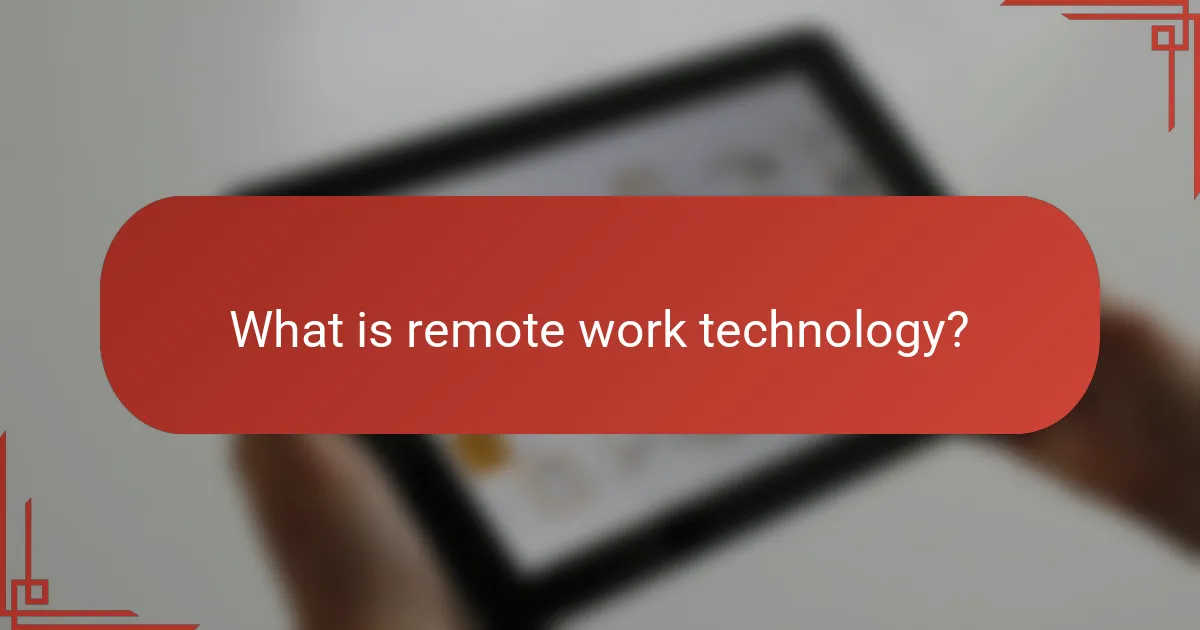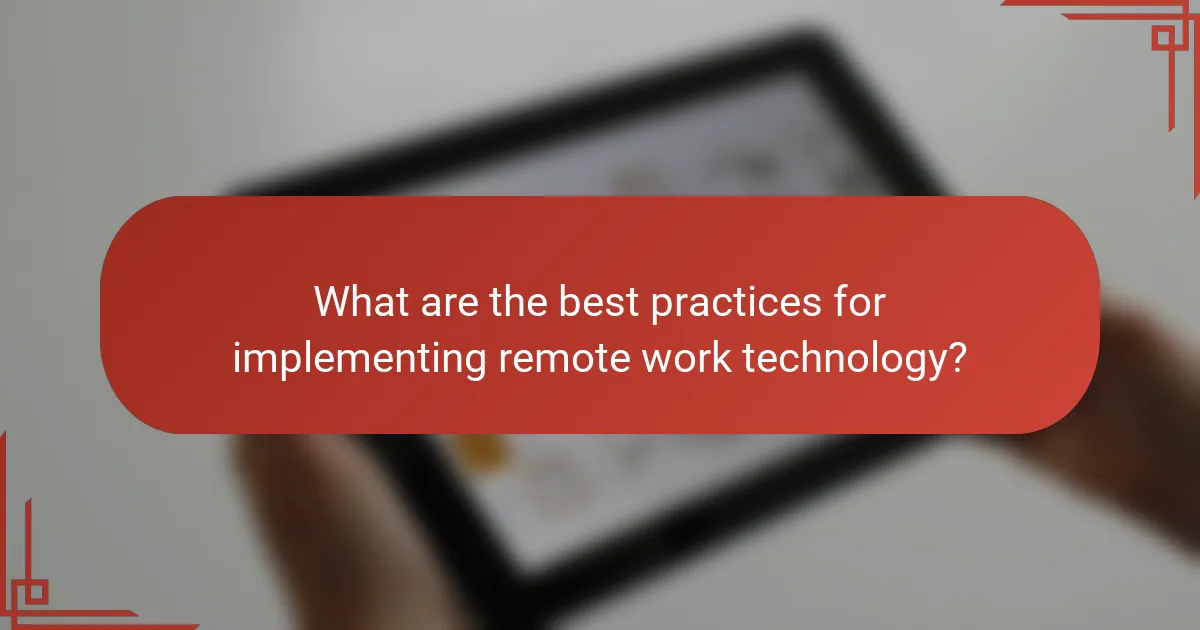Remote work technology encompasses the tools and systems that facilitate employees working outside traditional office settings, including communication software, project management applications, and collaboration platforms. The article explores the significant growth of these technologies, particularly accelerated by the COVID-19 pandemic, and highlights the increasing demand for remote work, with 97% of remote workers expressing a desire to continue working remotely at least part-time. It also discusses the influence of artificial intelligence and automation on enhancing productivity and efficiency in remote work environments, along with emerging trends like virtual reality and augmented reality. Best practices for implementing remote work technology, such as selecting user-friendly tools, ensuring cybersecurity, and providing training, are also outlined to support effective remote collaboration and employee satisfaction.

What is remote work technology?
Remote work technology refers to the tools and systems that enable employees to work from locations outside of a traditional office. This technology includes software for communication, project management, and collaboration. Examples include video conferencing platforms like Zoom and messaging apps like Slack. These tools facilitate real-time interaction and information sharing among remote teams. According to a 2021 report from Buffer, 97% of remote workers want to continue working remotely at least part-time. This indicates the effectiveness of remote work technology in supporting flexible work arrangements. The adoption of such technologies has increased significantly, especially during the COVID-19 pandemic, highlighting their importance in modern work environments.
How has remote work technology evolved over time?
Remote work technology has evolved significantly over the past few decades. Initially, remote work relied on basic tools like email and phone calls. The introduction of high-speed internet in the late 1990s enabled more robust communication methods. Video conferencing tools like Skype emerged in the early 2000s, enhancing virtual meetings. Cloud computing, which gained traction in the 2010s, allowed easy access to shared documents and collaboration. The COVID-19 pandemic in 2020 accelerated the adoption of remote work technologies. Companies rapidly integrated platforms like Zoom and Microsoft Teams for seamless collaboration. As of 2023, remote work technology continues to advance with AI-driven tools and enhanced cybersecurity measures. This evolution reflects the growing demand for flexible work arrangements and improved productivity.
What historical events contributed to the rise of remote work technology?
The rise of remote work technology was significantly influenced by several historical events. The advent of the internet in the 1990s enabled widespread connectivity. This connectivity allowed employees to communicate and collaborate from different locations. The dot-com boom further accelerated the development of online tools and platforms. The 2008 financial crisis led many companies to adopt cost-saving measures, including remote work. The COVID-19 pandemic in 2020 forced organizations to implement remote work at an unprecedented scale. This shift demonstrated the feasibility and benefits of remote work technology. Each of these events contributed to the evolution and acceptance of remote work practices.
What key innovations have shaped remote work technology?
Key innovations that have shaped remote work technology include cloud computing, video conferencing, and collaboration tools. Cloud computing allows access to files and applications from anywhere, enhancing flexibility. Video conferencing tools like Zoom and Microsoft Teams facilitate real-time communication, bridging geographical gaps. Collaboration platforms such as Slack and Trello streamline project management and team interaction. Additionally, advancements in cybersecurity have improved data protection for remote workers. These innovations have transformed how teams operate, making remote work more efficient and effective.
What are the primary tools used in remote work technology?
The primary tools used in remote work technology include communication platforms, project management software, and cloud storage solutions. Communication platforms like Zoom and Slack facilitate real-time discussions and collaboration. Project management software such as Trello and Asana help teams organize tasks and track progress. Cloud storage solutions like Google Drive and Dropbox enable secure file sharing and access from anywhere. These tools collectively enhance productivity and streamline workflows for remote teams.
Which communication tools are most popular for remote teams?
The most popular communication tools for remote teams include Slack, Microsoft Teams, Zoom, and Google Meet. Slack is widely used for team messaging and collaboration. Microsoft Teams integrates communication with Office 365 applications. Zoom is favored for video conferencing and webinars. Google Meet offers secure video calls and integrates well with Google Workspace. According to a 2022 survey by Buffer, 56% of remote workers reported using Slack, while 43% used Zoom for communication. These tools enhance collaboration and connectivity among remote teams.
How do project management tools enhance remote collaboration?
Project management tools enhance remote collaboration by providing centralized platforms for communication and task management. These tools facilitate real-time updates, ensuring all team members are informed about project progress. Features such as file sharing streamline access to necessary documents. Task assignment and tracking improve accountability among team members. Integration with other applications allows seamless workflows. According to a survey by the Project Management Institute, 71% of organizations use project management tools to improve collaboration. This statistic underscores the effectiveness of these tools in fostering teamwork in remote settings.
What benefits does remote work technology provide?
Remote work technology provides flexibility and improved work-life balance. Employees can choose their work environment and schedule. This leads to increased job satisfaction and productivity. According to a study by Buffer, 98% of remote workers want to continue working remotely at least part-time. Remote work technology also reduces commuting time, saving employees an average of 54 minutes daily. This extra time can be used for personal activities or additional work tasks. Enhanced collaboration tools foster better communication among team members. Companies can also access a broader talent pool without geographic limitations. Overall, remote work technology enhances efficiency and employee well-being.
How does remote work technology improve employee productivity?
Remote work technology improves employee productivity by providing flexible work environments and enhancing communication. Tools like video conferencing and instant messaging facilitate real-time collaboration. This allows employees to connect easily, regardless of location. Studies show that remote workers often report higher job satisfaction. Increased satisfaction leads to improved focus and efficiency. According to a 2021 report by Airtasker, remote workers save an average of 1.4 hours per day by eliminating commute times. This extra time can be redirected towards work tasks. Additionally, remote work technology enables better task management through project management software. These tools help prioritize work and track progress effectively. Overall, the integration of remote work technology fosters a more productive workforce.
What cost savings can businesses achieve through remote work technology?
Businesses can achieve significant cost savings through remote work technology. Remote work reduces overhead expenses, such as office space and utilities. According to a report by Global Workplace Analytics, companies can save an average of $11,000 per year for each employee who works remotely half of the time. This is due to lower costs in real estate and facility management. Additionally, businesses can save on equipment and supplies, as employees often use their own devices. Reduced commuting costs also contribute to savings, with employees spending less on transportation. Furthermore, remote work can lead to increased productivity, which indirectly saves costs associated with inefficiencies. Overall, remote work technology can provide substantial financial benefits for businesses.

What trends are shaping the future of remote work technology?
Artificial intelligence and automation are significantly shaping the future of remote work technology. These technologies enhance productivity by streamlining tasks and improving efficiency. Companies are increasingly adopting AI-driven tools for project management and communication. Remote collaboration platforms are integrating AI features for real-time assistance. Additionally, virtual reality (VR) and augmented reality (AR) are emerging trends in remote work. They provide immersive experiences for team meetings and training sessions. The global remote work market is expected to grow, with a projected value of $90 billion by 2026. This growth underscores the increasing reliance on advanced technology in remote work environments.
How is artificial intelligence influencing remote work tools?
Artificial intelligence is significantly influencing remote work tools by enhancing automation and improving user experience. AI-driven tools streamline workflows by automating repetitive tasks, allowing employees to focus on more strategic work. For example, AI can schedule meetings, manage emails, and generate reports, reducing the time spent on administrative duties.
Additionally, AI enhances communication through smart chatbots that provide instant support and information. These chatbots can answer common queries, freeing up human resources for complex issues. AI also personalizes user experiences by analyzing data to tailor recommendations and features to individual preferences.
In terms of collaboration, AI tools facilitate real-time translation and transcription, breaking down language barriers in global teams. This capability improves accessibility and inclusivity in remote work environments. According to a report by McKinsey, companies that adopt AI in their operations can increase productivity by up to 40%.
Overall, AI is transforming remote work tools by making them more efficient, responsive, and user-friendly.
What AI features are becoming standard in remote work technology?
AI features becoming standard in remote work technology include automated scheduling, virtual assistants, and enhanced collaboration tools. Automated scheduling uses algorithms to optimize meeting times across different time zones. Virtual assistants help manage tasks and reminders, improving productivity. Enhanced collaboration tools leverage AI to provide real-time language translation and smart document editing. These features streamline workflows and facilitate communication among remote teams. Research shows that 73% of remote workers benefit from AI-driven tools that enhance their efficiency. As remote work continues to grow, these AI features are expected to become essential components of the technology landscape.
How can AI improve team collaboration in remote settings?
AI can improve team collaboration in remote settings by enhancing communication, automating tasks, and providing data-driven insights. AI-powered tools facilitate real-time communication through chatbots and virtual assistants. These tools help manage schedules and streamline workflows, reducing the time spent on administrative tasks. AI can analyze team interactions to identify collaboration patterns and suggest improvements. According to a report by McKinsey, organizations that use AI for collaboration see a 20-25% increase in productivity. AI-driven platforms can also personalize user experiences, making collaboration more efficient and tailored to individual team members’ needs.
What role does cybersecurity play in remote work technology?
Cybersecurity is essential in remote work technology to protect sensitive data and systems. With employees accessing networks from various locations, vulnerabilities increase significantly. Cyber threats such as phishing, malware, and data breaches can compromise company information. A report by Cybersecurity & Infrastructure Security Agency (CISA) highlights that remote work has led to a 400% increase in cyberattacks. Implementing robust cybersecurity measures, such as VPNs and encryption, safeguards against these risks. Additionally, regular training on security protocols enhances employee awareness. Therefore, cybersecurity is a critical component in ensuring the integrity and confidentiality of remote work environments.
What are the common security challenges faced by remote workers?
Remote workers face several common security challenges. These include insecure home networks, which are often less protected than corporate environments. Many remote workers use personal devices that may lack adequate security measures. Phishing attacks targeting remote workers have increased, exploiting their isolation. Additionally, data breaches can occur due to unsecured file sharing methods. Employees may also struggle with maintaining strong passwords and using multi-factor authentication. The lack of security awareness training can leave remote workers vulnerable to cyber threats. According to a report by Cybersecurity Insiders, 70% of organizations have experienced a security incident related to remote work.
How can organizations enhance security for remote work technology?
Organizations can enhance security for remote work technology by implementing multi-factor authentication (MFA). MFA adds an extra layer of security beyond just passwords. It requires users to provide two or more verification factors to gain access. This significantly reduces the risk of unauthorized access.
Additionally, organizations should conduct regular security training for employees. This training raises awareness about phishing attacks and other cyber threats. Well-informed employees are less likely to fall victim to security breaches.
Using a Virtual Private Network (VPN) is also essential. A VPN encrypts internet traffic, protecting sensitive data from interception. This is particularly important when employees access company resources from public networks.
Organizations should also ensure that all software is regularly updated. Software updates often contain security patches that fix vulnerabilities. Keeping software up to date minimizes the risk of exploitation by cybercriminals.
Finally, implementing endpoint security solutions can protect devices used for remote work. These solutions can detect and respond to threats in real-time. This proactive approach enhances the overall security posture of the organization.

What are the best practices for implementing remote work technology?
The best practices for implementing remote work technology include selecting user-friendly tools, ensuring robust cybersecurity measures, and providing adequate training. User-friendly tools enhance productivity and reduce frustration. Cybersecurity measures protect sensitive data and maintain compliance with regulations. Adequate training empowers employees to utilize tools effectively. Regular feedback sessions help identify challenges and improve processes. Integrating collaboration tools fosters communication among remote teams. Establishing clear protocols for remote work ensures consistency and accountability. These practices lead to successful remote work technology implementation and increased employee satisfaction.
How can organizations effectively transition to remote work technology?
Organizations can effectively transition to remote work technology by implementing structured planning and training. First, they should assess their current technology infrastructure. This ensures compatibility with remote work tools. Next, organizations must select appropriate software for communication and collaboration. Tools like Zoom, Slack, and Microsoft Teams are popular choices.
Training employees on these tools is crucial for smooth adoption. Providing clear guidelines on remote work policies enhances productivity. Organizations should also establish regular check-ins to maintain team engagement. According to a study by Buffer, 98% of remote workers prefer to work remotely at least some of the time. This indicates a strong preference for remote work environments.
Finally, organizations should gather feedback to continuously improve remote work processes. This iterative approach ensures that technology meets evolving needs.
What strategies can help in training employees on new tools?
Effective strategies for training employees on new tools include hands-on workshops and interactive tutorials. Workshops allow employees to engage directly with the tools. This method increases retention and understanding. Interactive tutorials provide step-by-step guidance. They enable employees to learn at their own pace. Regular follow-up sessions reinforce learning and address challenges. Providing access to online resources supports continuous learning. Encouraging peer-to-peer training fosters collaboration and knowledge sharing. Utilizing feedback mechanisms helps improve training programs. These strategies have been shown to enhance tool adoption rates and overall employee productivity.
How can feedback be used to improve remote work technology adoption?
Feedback can be used to improve remote work technology adoption by identifying user needs and preferences. It allows organizations to understand the challenges users face with the technology. Regular feedback collection through surveys or interviews can highlight specific pain points. This information helps in making targeted improvements to the tools. For example, a study by Microsoft found that 70% of employees felt their productivity increased with better technology support. Implementing feedback-driven enhancements can lead to higher user satisfaction and increased adoption rates. Additionally, continuous feedback loops can foster a culture of innovation and responsiveness within the organization.
What tips can enhance the remote work experience?
Establishing a structured routine enhances the remote work experience. A consistent schedule helps maintain productivity and work-life balance. Setting specific work hours creates boundaries between personal and professional time. Utilizing task management tools can organize daily responsibilities effectively. Regular breaks improve focus and prevent burnout. Creating a dedicated workspace minimizes distractions and promotes a professional atmosphere. Engaging in virtual team-building activities fosters collaboration and strengthens relationships among remote workers. Lastly, maintaining open communication through various platforms ensures clarity and connection within the team.
How can individuals maintain work-life balance while working remotely?
Individuals can maintain work-life balance while working remotely by setting clear boundaries between work and personal time. Establishing a designated workspace helps create a physical separation from home distractions. Scheduling regular breaks throughout the day enhances productivity and mental well-being. Utilizing time management techniques, like the Pomodoro technique, can improve focus and efficiency. Communicating availability to colleagues ensures expectations are clear. Engaging in regular physical activity contributes to overall health and stress relief. Additionally, prioritizing personal time for hobbies and family fosters a sense of fulfillment. Research shows that remote workers who establish these practices report higher job satisfaction and lower stress levels.
What practices can improve communication within remote teams?
Establishing clear communication protocols can significantly improve communication within remote teams. Regular check-ins help maintain alignment among team members. Utilizing collaboration tools like Slack or Microsoft Teams facilitates real-time communication. Setting specific communication channels for different topics reduces confusion. Encouraging video calls fosters personal connections and enhances understanding. Providing feedback consistently ensures that team members feel heard and valued. Documenting discussions in shared spaces allows for transparency and reference. Training on effective communication practices can further enhance skills among team members.
Remote work technology encompasses the tools and systems that facilitate work outside traditional office settings, including communication, project management, and collaboration software. The article explores the evolution of remote work technology, highlighting key innovations such as cloud computing and video conferencing that have transformed how teams operate. It also discusses the benefits of remote work technology, including enhanced productivity, flexibility, and cost savings for businesses, while addressing the importance of cybersecurity in remote environments. Additionally, the article examines emerging trends like artificial intelligence and automation that are shaping the future of remote work technology.


